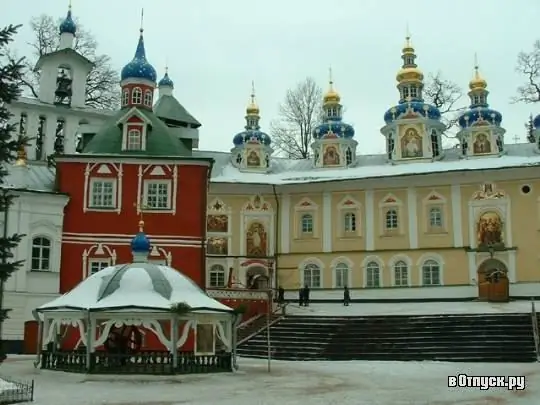
Description of the attraction
In honor of the great feast of the Assumption of the Mother of God, the main and oldest cathedral church of the Pskov-Pechersk Monastery was consecrated. Initially, at this place, the Monk Jonah excavated a not very large cave, in which he equipped the church. After the work was completed and the church was ready, with a request for consecration, Father Jonah turns to the priests of the Cathedral of the Holy Trinity, located in Pskov, but his request was refused due to the unusual location of the temple. After the refusal, Father Jonah asked for the blessing of Theophilos, Archbishop of Novgorod, who ordered the Pskov priests to satisfy the request of the Monk Jonah and consecrate the temple. The consecration ceremony took place in 1473 on August 15 (28). It was from this year that the history of the monastery was calculated.
After seven years, after the rite of consecration of this church, the Monk Jonah departed to the Lord. His successor was the priest Misail, who set up a cenobitic monastery on the Holy Mountain. He rebuilt cells and a church made of wood in honor of the Monks Anthony and Theodosius of Kiev-Pechersk. On the central square, which is located right in front of the Assumption Cathedral, there is a well, which is a source of "living water". A chapel was built directly above it, on the façade of which there are icons in special niches. Initially, the Assumption Church was only a small cave built in the slope of a sandy mountain, but later it was transformed, passages deepened into the mountain.
A wide multi-stage staircase leads to the Assumption Church, which ends with architectural decorations. A picturesque fresco - the image of the Kiev Mother of God - is placed above the entrance to the temple. On the slope of the roof, which faces the monastery, there are five chapters crowned with crosses in a row, the necks of the heads are decorated with sacred images.
The internal structure of the temple is just as unusual. The temple has five aisles in width and three in length, the aisles are separated by earthen camps lined with bricks and pillars. This creates a special cosiness. In a rather large space, there is an opportunity to find a "little corner" and in the light of the lamps, under the vault of the cave, to pray quietly.
In the main aisle, behind the dais, there is a royal place. This is a special canopy, where in the old days the tsar performed prayers when he was in the Pskov-Pechersky monastery. In continuation of the iconostasis of the main chapel, behind the pillars that support the vault, is the iconostasis of the chapel in memory of St. Anthony and Theodosius of the Pechersky. The first time this side-chapel was consecrated in 1523, but after rebuilding in the middle of the 18th century, it was consecrated anew. Behind the iconostasis you can see the preserved ancient frescoes depicting the holy fathers. The main ancient relics of the monastery are kept in the church - the icon "The Dormition of the Mother of God", acquired in 1521, which belongs to the brush of the Pskov icon painter Alexei Maly, as well as the icon "The Tenderness of the Mother of God of Pskov-Pecherskaya" and a rare fresco made in the 16th century - "Procession the righteous. " In the depths of the Assumption Cathedral, near the wall on the south side, in a specially arranged niche, rest the relics of the Monk Martyr Cornelius, the holy hegumen of this monastery. In the main chapel of the Assumption Church, there are two revered images copied from the miraculous Pskov-Pechersk Icon of the Mother of God "Tenderness", which showed many miracles, however, like the icon of the Assumption of the Most Holy Theotokos.
Next to the Assumption Cathedral is the entrance to the especially revered monastery Holy Caves. Every year in August on the 28th, the Feast of the Dormition of the Most Holy Theotokos is held in Pechory, and every year at this time the monastery is visited by a huge number of pilgrims from all over Russia and other Orthodox lands.






